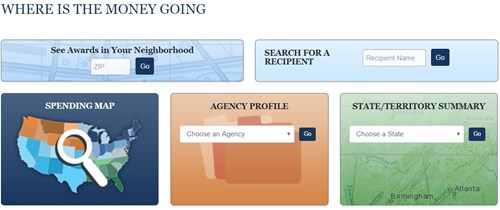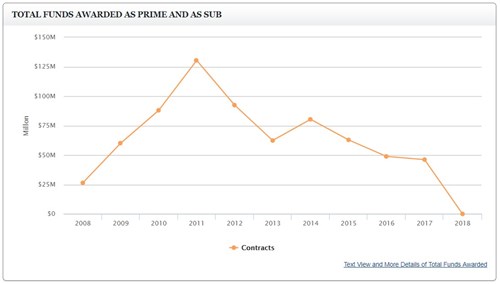Wednesday, January 31 2018
Free Government Websites: Gateways to Increased Government Business
As I speak to Indiana manufacturers about the Defense Manufacturing Assistance Program (DMAP) at Purdue Manufacturing Extension Partnership (MEP), I find that many business owners are surprised at the level of detail that is available on free government websites regarding the products in which they specialize, the size of the federal marketplace for their products, what agencies are buying products in their specialty code and which companies are getting most of the sales. Not surprisingly, I also find that business leaders are too busy to invest the time to explore the depths of these websites. Purdue MEP has this knowledge and can help save you time. We have a resource who will dig through the websites and find the information that you need to more effectively compete in the government marketplace and grow your federal business. This article is intended to serve two purposes. First, it provides information regarding these free, easily-accessible sites and identifies a few of the website features. Second, this article highlights that Purdue MEP can save you time by conducting the federal marketplace searches for you.
The two free government sites I would like to highlight in this article are USAspending.gov and the Federal Procurement Data System (fpds.gov).
The Federal Funding Accountability and Transparency Act of 2006 (FFATA) was signed into law on September 26, 2006. The legislation required that federal contract, grant, loan, and other financial assistance awards of more than $25,000 be displayed on a searchable, publicly accessible website, USAspending.gov, to give the American public access to information on how their tax dollars are being spent. As a matter of discretion, USAspending.gov also displays certain federal contracts of more than $3,000.
Federal agencies are required to report the name of the entity receiving the award, the amount of the award, the location of the recipient, the place of performance location, as well as other information. In 2008, FFATA was amended by the Government Funding Transparency Act to require prime recipients to report details on their first-tier sub-recipients for awards made as of October 1, 2010.
As shown in the image below, you can start your search by zip code, award recipient name, geographically (using a map feature), agency, or state. For example, if I wanted to know how much money the Department of Defense (DoD) was spending in Indiana and how much money DoD is spending with a particular prime contractor, I would select the “State/Territory Summary.” This information could be used to develop a marketing/networking plan to target a specific DoD prime contractor that is above your company in the DoD supply chain.

DMAP is a grant program designed to assist small-to-medium size Indiana manufacturers in the DoD supply chain who have experienced a downturn in their DoD revenue, so I like to use the “Where is the Money Going” tab and then click on the “Recipient Profile.” After entering the name of the company or DUNS number, the site displays a chart such as the one seen below that graphically indicates the history of awards/contracts with the federal government. In this case, it is apparent that direct sales to the government/T1 sales to a prime contractor have declined. Purdue MEP has manufacturing consulting and services that could help reverse this negative trend. A list of our services can be viewed here: https://mep.purdue.edu/services/

USAspending.gov is certainly a more powerful resource than I can demonstrate in a few paragraphs, so I recommend you go to the site and try it! No registration is required.
Federal Procurement Data System (fpds.gov)
The second website I would like to introduce is fpds.gov. Fpds.gov provides information on federal contract awards greater than $3500 to the public. Here are the key features of fpds.gov:
- Many agencies now submit contract actions to FDPS as soon as the contract is awarded.
- Twenty-seven standard reports are available to the Public.
- Advanced search capability is available to everyone.
- Data and reports are available in real-time and free.
Unlike USAspending.gov, you must register for this site, provide a username and create a password. Additionally, fpds.gov only displays the federal contract awards greater than $3500, not the federal loan and grant information that is included in the USAspending.gov data.
Personally, I prefer to fpds.gov when I want to create a spreadsheet of federal contract awards to a particular business, sorted by year, or a spreadsheet that includes all contracts for a specific product specialty code (PSC). The spreadsheet sorted by PSC provides great information about your competition. You can determine the agency, who purchased the product, how much money was spent, when the money was spent, the contractor name, etc.
Please see the image below. In this case, I used the ezSearch tab and sorted my search on PSC 5962 (microcircuits, electronic) and DoD. The result shows that the Defense Logistics Agency (DLA) is the largest buyer of microcircuits in DoD. (Question: Do you have a DLA Internet Bulletin Board (DIBBs) account so that you can receive these solicitations?) Additionally, you can view the vendors who won the award, the date, award amount, and summary contract information. Using the sort order tab in the lower right corner, you could sort the list by date if you wanted to see the most recent awards. If you wanted to share this information or manipulate the information in a spreadsheet, just select the CSV tab on the top right of the display.

Although you can’t access the contract line items, you can see the summary level information regarding a specific procurement (select the “view” tab on the Award ID line) such as the description of the item, whether it was competitively bid or sole source or if it was a set-aside contract. You must contact the Contracting Officer, using a FOIA request, to get the contract file, proposals, etc.
Fpds.gov and USAspending.gov are fantastic sources of information regarding federal contracts and awards, however, they do require an investment of time to learn how to navigate the systems. If you are interested in pursuing business in the federal marketplace, but you don’t have the time to research, please contact Purdue MEP to help. Not only do we have resources to conduct searches for you, but also the DMAP grant can pay for 50-90% of the cost of the research for eligible companies. I am available to answer your questions at Purdue MEP – Defense Manufacturing Assistance Program – Eugene Jones – jonesew@purdue.edu.
Writer: Gene Jones, 765-496-7802, jonesew@purdue.edu


